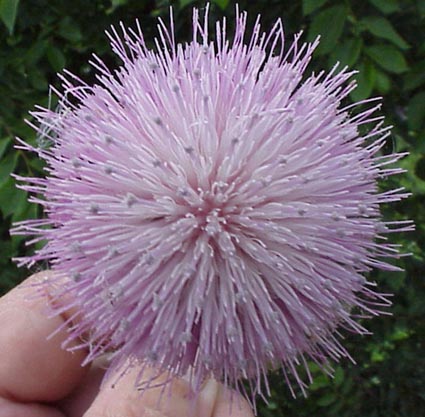Musk Thistle
Carduus natans
Photos Leafy spurge and musk thistle
Musk thistle is a name for several species and subspecies of plant. These can also be called Carduus theormeri. This group includes C. nutans, C. macrocephala, and C. theormeri=C. nutans with the subspecies leiophyllus.Roots: The roots are numerous in the fall. They have large and fleshy taproot in the spring.
Stems and Leaves: The stem is erect, branched, with spiny leaves extending down the side, giving it the appearance of being winged. The leaves are light to deep green in color.
Flowers: Musk thistle flowers are usually solitary, slightly bent, and are a variety of colors, for example reddish-purple, deep rose, violet, and occasionally white. The head of the flower is flat on back. One key characteristic is the large, brown bracts that resemble pine cones.
Fruits and seeds: The seeds are oblong, straw-colored, and are produced anywhere from June to July. About 2% of the seeds are attached to the pappus and are borne on the wind. The other 98% either fall to the ground close to the parent plant or are scattered around by birds, running water, and small animals.
Reproduction: The reproduction of this weed is totally done through seeds.
this picture is from Musk thistle; pictures of the different stages of growth and descriptive information.
Life duration/habit: Musk thistle is usually a biennial, a winter annual, or an annual. The seeds germinate about six to eight weeks after they have fallen on the ground, but can remain dormant for years in the soil. The actual plant can reach about 6 ft in height under the correct conditions.Biological control: There are three biological control agents that we can use to control this weed. These control agents are, but not limited to, Chelilosia corydon, Rhinocyllus conicus, and Thrichoisirocalus borridus.
Chelilosia corydon is a black fly with yellow, fuzzy-hair, which resembles a bee. It can be anywhere from 13 to 15 mm long, including it's wings. It's most destructive when in larval stage. Attacks musk thistle, Italian thistle (C. pycnocephalus), and plumeless thistle (C. acanthoides). These weeds are attacked at leaves, stem, and crown of the plant. When the larvae feeds it interrupts the plants nutrient and moisture transport system and retards inflorescence development, thus lowers seed production. When more than one larvae infest the root, the plant often dies.
this picture from Rhinocyllus conicus.
Rhinocyllus conicus is a weevil. They are reddish-tan to black, have body hair which is a patchy mixture of black and yellow. This weevil has a short snout and is about 5 to 6 mm long. Most destructive when in larval stage. The host thistles species include Carduus, Cirsium, Onopordum, and Silybum. They attack the seed head and sometimes stem. Adults may slightly defoliate plants. Since the insect attacks the seed-producing tissue, this weevil is extremely effective by itself in those areas where the plant and insect life cycles are synchronized.Trichosirocalus horridus are about 3.5 to 4.5 cm long, stout, brown weevils with strong tubercles on the prothorax and spines on the back. they emerge from late June into July. The destructive stage is larval. Plant species attacked are C. thoermeri = C. nutans, Carduus acnthoides, Carfuus ycnocephalus, Cursiun arvense, C. vulgare, and Onopordum acanthium. Adults are usually found feeding on the young rosette leaves. Larval attack the rosette's growing tips, and will not touch small rosettes or seedlings. Weak plants often succumb to moderate populations of this agent. There are several reports of areas where the plant population has been greatly reduced.
picture from Musk Thistle
Resources:1) McDonald, Richard et. al., Integrated Control or Musk Thistle using an introduced weevil [web site] http://www.muextension.missouri.edu/xplor/agguides/crops/g04867.htm
2) Musk or Nodding Thistle (Cadduus nutans) Plumeless or Bristly Thistle (Carduus acanthoides) Bull Thistle (Cirsium vulgare) [web site] http://www.dnr.state.wi.us/org/land/er/incasive/factsheets/thistles.htm
3) L. T. Kok, Trichosirocalus hurridus (Coleoptera: Curculionidae) [web site] http://nysaes.cornell.edu/ent/biocontrol/weedfeeders/trichosirocalus_h.html
4) Rees, N. E., et. al., Biological control of weeds in the west "Musk thistle Carduul natuns (group)."
5) Rees, N. E., et. al., Biological control of weeds in the west, "Rhinocyllus conicus."
6) Rees, N. E., et. al., Biological control of weeds in the west, "Trichosirocalus horridus"
7) Rees, N. E., et. al., Biological control of weeds in the west, "Cheilosia corydon"
musk-thistle mtwow.org HOME New-Weed-Alerts
This page was made by Alissa Frazer and Jody Singleton on March 16, 2001.
Alissa.

